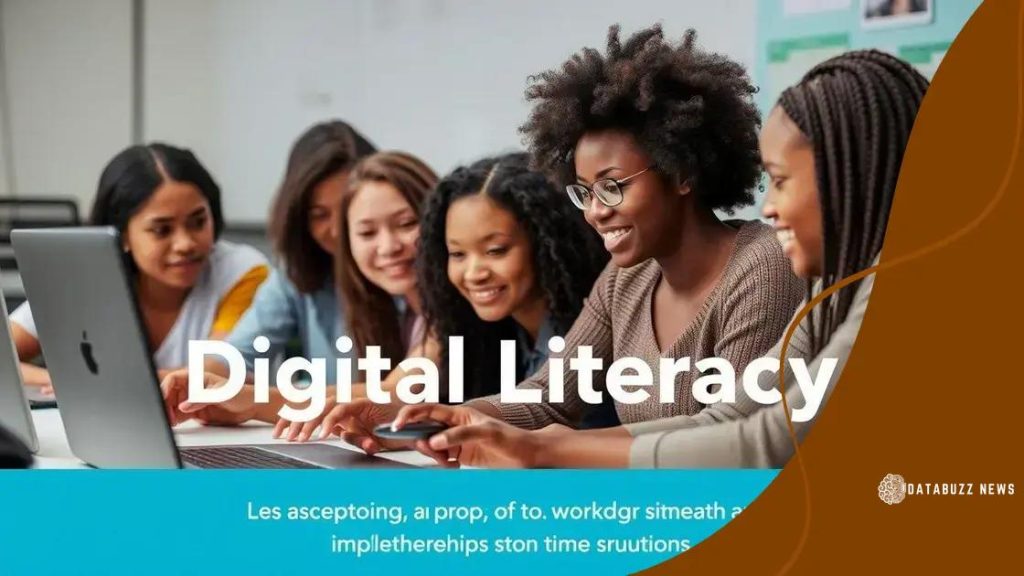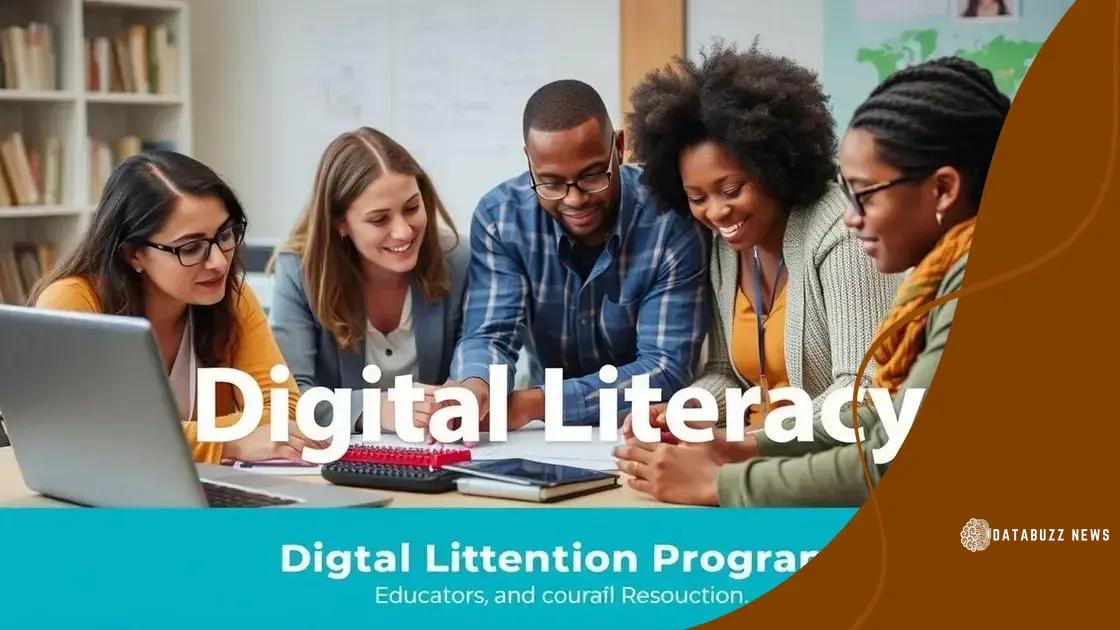Implementations of digital literacy programs for everyone

Measuring the success of digital literacy programs involves tracking quantitative and qualitative metrics, participant feedback, and long-term impacts to ensure these initiatives effectively empower individuals and meet community needs.
Implementations of digital literacy programs play a crucial role in bridging the skills gap in our increasingly digital world. Have you ever wondered how these initiatives can transform communities and enhance opportunities? Let’s dive into the core aspects of these programs and their significance.
Understanding digital literacy programs
Understanding digital literacy programs is essential in today’s technology-driven world. These programs aim to equip individuals with the skills needed to navigate and use digital tools effectively. By fostering these skills, communities can enhance their overall technological engagement.
What are Digital Literacy Programs?
Digital literacy programs refer to initiatives designed to teach people how to use technology and digital platforms. They cover various aspects, including basic computer skills, internet safety, and online communication.
Key Components of These Programs
- Basic technology skills
- Internet research techniques
- Understanding online privacy and security
- Effective communication in digital spaces
These components ensure that participants can navigate the digital landscape confidently. As technology evolves, it’s vital to continually update curriculum and instructional methods within these programs.
Moreover, demand for digital skills is surging. In many sectors, being digitally literate has become a prerequisite for employment. Therefore, these programs are an essential part of workforce development. Schools, nonprofits, and community organizations increasingly implement them to address this critical need.
Benefits of Digital Literacy Programs
There are multiple benefits tied to participating in digital literacy initiatives. One of the most significant advantages is improved access to information. By becoming digitally literate, individuals can better engage with content ranging from job postings to educational resources.
- Enhanced job opportunities
- Improved critical thinking skills
- Greater civic engagement
Another benefit involves fostering a greater sense of community. Participants in these programs often collaborate and support one another, creating supportive networks. These networks can lead to increased social cohesion within various demographics.
The impact of digital literacy on communities
The impact of digital literacy on communities is profound and far-reaching. As more individuals gain access to technology, the overall skill level of the community improves, leading to many benefits.
Enhanced Communication
One of the primary effects is enhanced communication. When community members possess digital skills, they can easily connect with one another. This fosters collaboration and the sharing of ideas. People can organize events, keep the community informed, and engage in discussions.
Economic Opportunities
Digital literacy also opens up new economic opportunities. Individuals who are digitally literate are more likely to find employment. They have the skills needed for many jobs that require basic computer skills or online communication.
- Increased job applications
- Access to remote work options
- Skills for starting digital businesses
Moreover, local businesses benefit from a digitally literate population. They can market effectively online and improve customer engagement.
Community Empowerment
Communities with strong digital literacy programs empower residents. When individuals have the tools to succeed, they feel more confident and capable. This empowerment can lead to activism and advocacy for local issues. Furthermore, education initiatives that focus on digital skills encourage lifelong learning that benefits entire generations.
Ultimately, the ripple effect of enhanced digital literacy reaches beyond individual growth. Communities thrive as they embrace technology and the opportunities it brings. In every corner, increased knowledge leads to a more active, engaged, and thriving society.
Strategies for effective program implementation

Implementing digital literacy programs effectively requires well-planned strategies. The right approach can make a significant difference in reaching the community and having a lasting impact.
Understanding Your Audience
One of the first steps is to understand your audience. Different groups may have varying levels of digital skills. For example, young adults may need advanced training while seniors may require basic skills. Tailoring the content to fit these needs is crucial for engagement.
Partnerships and Collaboration
Building partnerships can amplify the reach of your program. Collaborating with local businesses, schools, and community organizations can provide resources and support. These partnerships can enhance visibility and attract more participants.
- Engage local stakeholders for support
- Utilize existing networks to promote the program
- Share resources with partner organizations
When organizations work together, they can create a comprehensive support system that benefits everyone involved.
Utilizing Technology for Teaching
Incorporating technology into the training itself makes the learning process relatable. Using interactive tools can capture participants’ attention. From online courses to mobile apps, the medium of instruction is vital.
- Interactive quizzes and games
- Accessible learning platforms
- Video tutorials for hands-on practice
Choosing the right mediums ensures that participants remain engaged and grasp the material effectively. This also encourages a sense of accomplishment as they progress.
Feedback and Improvement
Gathering feedback is essential after each session. Knowing what works well and what needs adjustment helps refine the program. Surveys and informal discussions can provide valuable insights into participants’ experiences.
By constantly evolving, a digital literacy program can better serve the community and significantly increase participants’ skills. Success comes from dedication, adaptability, and a focus on meeting learners’ needs.
Challenges in executing digital literacy initiatives
Executing digital literacy initiatives comes with various challenges that can hinder their success. Understanding these obstacles is essential for creating effective programs.
Lack of Resources
One significant challenge is the lack of access to necessary resources. Many communities struggle to find funding for technology and training materials. Without adequate resources, it becomes difficult to implement a comprehensive program.
Resistance to Change
Another challenge is resistance to change. Some individuals may be hesitant to embrace new technology or ideas. This skepticism can stem from fear of the unknown or previous negative experiences. Addressing these concerns is crucial for encouraging participation.
- Offer reassurance through support
- Provide success stories to inspire
- Involve community leaders to advocate for change
By fostering an environment of acceptance, programs can thrive despite initial reluctance.
Difficulty in Measuring Success
Measuring the success of digital literacy initiatives is also challenging. Defining clear metrics to assess progress can be complex. It’s essential to establish both qualitative and quantitative measures.
- Track participant enrollment and attendance
- Gather feedback through surveys
- Evaluate participants’ skill improvements
Continuously assessing these factors can help organizations refine their approaches and ensure they meet the community’s needs.
Digital Divide
The digital divide poses another significant challenge. Not all community members have equal access to technology. This disparity can limit who benefits from digital literacy programs. Ensuring equitable access to resources is critical for success.
By recognizing and addressing these challenges, organizations can develop strategies to overcome barriers and effectively implement digital literacy initiatives. Success involves continuous adaptation and commitment to community engagement.
Measuring success of digital literacy programs
Measuring the success of digital literacy programs is essential to ensure they effectively meet their goals. It helps organizations understand their impact and improve future initiatives.
Defining Success Metrics
To begin, it’s crucial to define what success looks like for your program. Success metrics can vary depending on the program’s objectives. Some may focus on skills acquisition, while others may target community engagement.
Quantitative Measurements
Quantitative measures provide hard data to track progress. Common metrics include:
- Enrollment numbers in the program
- Attendance rates at training sessions
- Skills assessments before and after the program
Analyzing these metrics can help identify trends and areas needing improvement.
Qualitative Assessments
Qualitative assessments offer insights into participant satisfaction and engagement. Surveys, interviews, and focus groups allow participants to share their experiences.
- Gather feedback on the relevance of training materials
- Assess the clarity of instruction
- Identify challenges faced by participants
This feedback is invaluable for program refinement and participant retention.
Long-Term Impact Tracking
Success is not only about immediate results; long-term impact also matters. Tracking participants’ progress beyond the program can reveal whether they’ve effectively applied their skills.
Follow-up surveys can assess their ongoing digital engagement, employment opportunities, and contributions to their community. By measuring both short-term and long-term outcomes, programs can demonstrate their value.
FAQ – Frequently Asked Questions about Digital Literacy Programs
Why is measuring success important for digital literacy programs?
Measuring success helps identify what works well and what needs improvement, ensuring the program effectively meets community needs.
What are some common metrics used to evaluate these programs?
Common metrics include enrollment and attendance rates, participant feedback, and long-term impact assessments.
How can I gather feedback from participants?
You can gather feedback through surveys, interviews, or focus groups to understand participants’ experiences and improvements needed.
What challenges do organizations face in implementing these programs?
Organizations often face challenges like lack of resources, resistance to change, and difficulty in measuring success.
